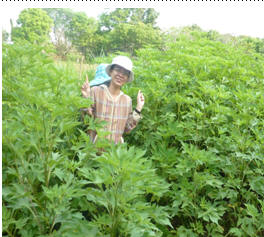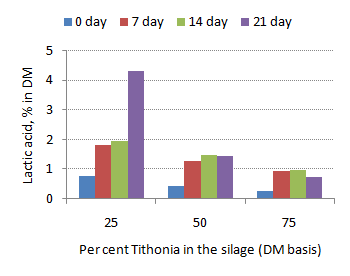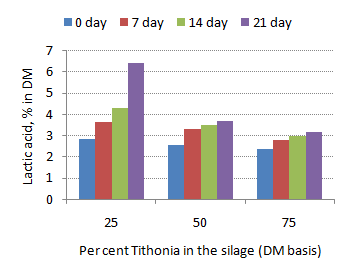
|
Live stock production, climate change and resource depletion |
The first experiment was conducted to evaluate effects on fermentation characteristics and nutritive value of ensiling Tithonia diversifolia leaves and petioles with leaves and petioles of Taro (Colocacia esculenta), with or without 5% molasses. The second experiment was a 4*4 Latin square arrangement applied to 4 crossbred castrated male pigs (60 kg live weight) fed diets with four levels of ensiled Tithonia:Taro with 5% molasses equivalent to 0, 10, 15 and 20 % substitution of a basal diet ir rice bran, broken rice, soybean meal and fish meal. . The pigs were housed in metabolism cages for consecutive periods of 15 days, with collection of feces during the last 5 days of each period.
All silages had an attractive smell. The pH in the ensiling mixture increased as the level of Tithonia was raised, and decreased with ensiling time, the decrease being more pronounced when molasses was added. Lactic acid decreased with increased level of Tithonia and increased with ensiling time, the relative increase being less marked as Tithonia levels were raised. In all cases the lactic acid concentration was higher with addition of molasses. There were only slight decreases in digestibility coefficients of DM, CP and NDF (range of 4-5%) as the Tithonia: Taro silage was increased from 0 to 20% of the diet. It is concluded that Tithonia:Taro silage is of relatively high nutritive value, in terms of digestibility of the DM, NDF and crude protein for pigs.
Tithonia diversifolia is widely distributed in the tropics. It grows well during the wet and dry season with high yields of DM and crude protein (Sao et al 2010). It is abundant in nature and also not in competitive demand for human consumption. Using Tithonia diversifolia for animal feed would therefore be an addition to the worldwide interest in investigating the use of non-conventional feed resources in animal diets.
The aim of the present study was: (i) to evaluate different methods of ensiling Tithonia diversifolia ; and (ii) using the ensiled foliage for fattening pigs.
Tithonia branches (Photo 1) were collected from the fields and separated into leaves + petioles and stems. Taro plants were collected from ponds in Cantho city. The leaves with petioles were chopped into small pieces (1-2cm) with a knife. After wilting for 4h, the Taro leaf + petiole was ensiled with the fresh Tithonia foliage according to the following treatments in a 3*2 factorial design with 3 replicates.
The factors were:
5% "A" Molasses or no additive
Proportion of foliage (leaves + petiole) of Taro (Colocacia esculenta): 25, 50 or 75% (DM basis)
Samples of the freshly processed foliages were taken before and 7, 14 and 21 days after ensiling for analysis of DM, crude protein, ADF, NDF, organic acids, oxalate and pH.

|
|
|
|
Photo 1. Tithonia diversifolia and Taro (Colocasia esculenta are abundant in Cantho |
|
|
|
|
|
Photo 2. Ensiling of Tithonia diversifolia leaves and Taro |
|
The trial was done according to a 4*4 Latin Square arrangement of 4 dietary treatments with four Landrace x Yorkshire castrated male pigs. The animals were housed in metabolism cages during the whole trial and allocated to the following dietary treatments
TDM0: basal diet
TDM10: 90% basal diet with 10% ETL of the diet TDM
TDM15: 85% basal diet with 15% ETL of the diet TDM
TDM20: 80% basal diet with 20% ETL of the diet TDM
The dietary ingredients in the basal diet were rice bran, ground maize, fish meal and soybean meal; TDM was the ensiled mixture of Tithonia and Taro (50:50 DM basis) with 5% molasses (Table 1).
|
Table 1. Composition of the dietary ingredients (% in DM, except for DM which is on air dry basis) |
|||||
|
|
DM |
Ash |
CP |
EE |
NDF |
|
Rice bran |
90.7 |
13.3 |
9.12 |
7.55 |
26.7 |
|
Broken rice |
86.3 |
0.89 |
10.68 |
0.59 |
7.91 |
|
Fish meal |
90.7 |
33.2 |
53.6 |
6.2 |
1.96 |
|
Soybean meal |
88.9 |
7.91 |
48 |
10.97 |
11.8 |
|
TMD |
18.7 |
17.2 |
20.0 |
7.72 |
33.8 |
|
Table 2. Ingredients and chemical composition of basal diet |
|
|
Rice bran |
45 |
|
Broken rice |
39 |
|
Soybean meal |
10 |
|
Fish meal |
4 |
|
Oyster meal |
1 |
|
Premix minerals-vitamins |
1 |
|
Chemical composition, % in DM (except DM which is on air-dry basis) |
|
|
DM |
86.9 |
|
Ash |
8.45 |
|
CP |
15.2 |
|
EE |
4.97 |
|
NDF |
11.8 |
|
Ca |
0.84 |
|
P |
0.7 |
Each experimental period consisted of 15 days; 10 days for adaptation to the
diets followed by another 5 days for collection of data. The pigs were weighed
at the start and at the end of each period. Feed intake and refusals were
recorded daily. Feeds were offered at close to
ad libitum feeding at 9.00 h and 15.00 h and water was available
throughout the experiment. Daily dry matter intake (DMI) and average daily gain
(ADG) were recorded for individual pigs and feed conversion ratio was calculated
as DMI divided by ADG.
Samples of feeds offered, refusals and feces were collected every day and 10% of the amount stored at -18 C until the end of each collection period of 5 days. Feed samples were analyzed in duplicate for dry matter (DM), ash, and ether extract (EE) according to the standard procedure of AOAC (1984). For determining crude protein (CP = N x 6.25) of feces, fresh samples were analyzed to avoid losing ammonia. Neutral detergent fibre (NDF) was analysed according to Van Soest et al (1991).
The data were analysed using the GLM option of the ANOVA
program in Minitab (2000). Sources of variation were treatments, pigs, periods
and error.
Increasing the Tithonia in the silage reduced the rate of decrease in the DM content of the silage with time of ensiling in the absence of molasses; with molasses, the rate of decrease of DM with time was less pronounced (Table 3). The pH in the ensiling mixture increased as the level of Tithonia was raised, and decreased with ensiling time (Figure 1), the decrease being more pronounced when molasses was added (Figure 2). Lactic acid decreased with increased level of Tithonia and increased with ensiling time, the relative increase being less marked as Tithonia levels were raised (Figure 3). In all cases the lactic acid concentration was higher with addition of molasses (Figure 4). Trends for acetic acid were similar to those for lactic acids but overall concentrations were lower. There were only minor changes in concentrations of crude protein, NDF and ADF. Levels of oxalate deceased with increasing level of Tithonia and with time of ensiling, and were lower when molasses was added (Figures 5 and 6). The benefits in silage parameters from addition of taro foliage to the Tithonia were similar to those reported by ---- Tien et al (2010) when they ensiled banana pseudo-stem with Taro foliage. It would appear that in the absence of molasses the optimum ratio of Tithonia to Taro is 25:75 and 50:50, while a ratio of 50:50 is acceptable with addition of molasses. Similar findings on the benefits of added molasses were reported by Fasuyi et al (2010) that Tithonia leaves could be ensiled with a pH of less than 5 after 14 days when 4% molasses was used as additive.
|
Table 3. Chemical composition of Tithonia diversifolia and Taro with or without molasses |
|||||||||
|
|
No additive |
Molasses |
P- value |
||||||
|
|
25TD |
50TD |
75TD |
25TD |
50TD |
75TD |
TD |
Additive |
TD*Additive |
|
DM, % |
|||||||||
|
0 day |
18.25 |
19.04 |
18.50 |
18.27 |
19.65 |
19.58 |
0.06 |
0.12 |
0.46 |
|
7 day |
14.95 |
16.61 |
17.88 |
18.17 |
18.72 |
18.40 |
0.01 |
0.001 |
0.04 |
|
14 day |
11.95 |
14.65 |
17.67 |
16.44 |
18.18 |
18.34 |
0.001 |
0.001 |
0.001 |
|
21 day |
11.02 |
13.66 |
17.31 |
15.29 |
17.88 |
18.15 |
0.001 |
0.001 |
0.001 |
|
CP, % DM |
|||||||||
|
0 day |
19.87 |
19.84 |
19.93 |
19.58 |
19.87 |
19.87 |
0.90 |
0.740 |
0.90 |
|
7 day |
19.48 |
20.21 |
19.96 |
20.64 |
21.00 |
20.80 |
0.39 |
0.001 |
0.58 |
|
14 day |
19.47 |
19.83 |
19.88 |
20.49 |
21.11 |
21.17 |
0.05 |
0.001 |
0.79 |
|
21 day |
18.92 |
19.34 |
19.80 |
20.51 |
21.13 |
21.26 |
0.03 |
0.001 |
0.82 |
|
ADF, % DM |
|||||||||
|
0 day |
25.43 |
24.82 |
24.63 |
25.69 |
24.25 |
24.17 |
0.01 |
0.34 |
0.39 |
|
7 day |
25.24 |
23.92 |
23.97 |
25.30 |
23.90 |
23.61 |
0.001 |
0.61 |
0.68 |
|
14 day |
25.10 |
23.51 |
23.66 |
25.08 |
23.65 |
23.28 |
0.001 |
0.75 |
0.73 |
|
21 day |
24.33 |
23.14 |
23.62 |
24.87 |
23.35 |
23.20 |
0.001 |
0.60 |
0.17 |
|
NDF, % DM |
|||||||||
|
0 day |
36.02 |
36.06 |
35.49 |
36.04 |
35.87 |
35.47 |
0.16 |
0.80 |
0.92 |
|
7 day |
35.07 |
35.36 |
34.67 |
35.67 |
34.76 |
34.03 |
0.21 |
0.64 |
0.47 |
|
14 day |
34.58 |
34.68 |
34.02 |
34.79 |
33.55 |
33.07 |
0.001 |
0.01 |
0.03 |
|
21 day |
33.86 |
34.16 |
33.64 |
33.71 |
32.55 |
32.47 |
0.01 |
0.001 |
0.009 |
|
Acetic acid, % in DM |
|||||||||
|
0 day |
0.51 |
0.30 |
0.18 |
2.31 |
2.10 |
1.98 |
0.001 |
0.001 |
1.00 |
|
7 day |
1.20 |
0.85 |
0.62 |
2.81 |
2.60 |
2.27 |
0.001 |
0.001 |
0.66 |
|
14 day |
1.29 |
0.97 |
0.70 |
3.27 |
2.72 |
2.38 |
0.001 |
0.001 |
0.06 |
|
21 day |
2.87 |
0.95 |
0.50 |
4.67 |
2.85 |
2.57 |
0.001 |
0.001 |
0.25 |
|
Lactic acid, % in DM |
|||||||||
|
0 day |
0.76 |
0.45 |
0.27 |
2.86 |
2.55 |
2.37 |
0.001 |
0.001 |
1.00 |
|
7 day |
1.80 |
1.27 |
0.94 |
3.62 |
3.30 |
2.81 |
0.001 |
0.001 |
0.60 |
|
14 day |
1.93 |
1.46 |
0.96 |
4.31 |
3.49 |
2.97 |
0.001 |
0.001 |
0.58 |
|
21 day |
4.31 |
1.43 |
0.75 |
6.41 |
3.68 |
3.16 |
0.001 |
0.001 |
0.34 |
|
Oxalate#, g/100g DM |
|||||||||
|
0 day |
2.50 |
1.87 |
1.50 |
2.40 |
1.87 |
1.56 |
0.001 |
0.71 |
0.19 |
|
7 day |
1.63 |
1.59 |
1.32 |
1.25 |
1.46 |
1.40 |
0.001 |
0.001 |
0.001 |
|
14 day |
1.57 |
1.55 |
1.24 |
1.10 |
1.14 |
1.00 |
0.001 |
0.001 |
0.001 |
|
21 day |
1.43 |
1.23 |
0.96 |
1.14 |
1.12 |
1.00 |
0.001 |
0.001 |
0.001 |
|
pH |
|||||||||
|
0 day |
5.80 |
6.31 |
6.81 |
5.67 |
6.20 |
6.75 |
0.001 |
0.09 |
0.87 |
|
7 day |
5.71 |
6.13 |
6.67 |
5.39 |
5.97 |
6.51 |
0.001 |
0.001 |
0.34 |
|
14 day |
5.57 |
6.06 |
6.53 |
4.99 |
5.76 |
6.22 |
0.001 |
0.001 |
0.18 |
|
21 day |
5.30 |
6.01 |
6.35 |
4.70 |
5.64 |
5.87 |
0.001 |
0.001 |
0.33 |
| #As (COO)2 | |||||||||
|
|
|
|
Figure 1. Effect on pH of ensiling Taro foliage with increasing percentage of Tithonia (without molasses) |
Figure 2. Effect on pH of ensiling Taro foliage with increasing percentage of Tithonia (with molasses) |
 |
 |
|
Figure 3. Effect on lactic acid concentration of ensiling Taro foliage with increasing percentage of Tithonia (without molasses) |
Figure 4. Effect on lactic acid concentration of ensiling Taro foliage with increasing percentage of Tithonia (with molasses) |
|
|
|
| Figure 5. Effect on oxalate concentration of ensiling Taro foliage with increasing percentage of Tithonia (without molasses) |
Figure 6. Effect on oxalate concentration of ensiling Taro foliage with increasing percentage of Tithonia (with molasses) |
There were linear decreases in feed intake, apparent digestibility coefficients and change in live weight as the proportion of Tithonia: Taro silage in the diet was increased (Table 4; Figure 7). However, the degree of change was slight (4, 5, 4 and 13% reduction for apparent digestibility coefficients of DM, CP and NDF, and change in live weight, respectively, as the silage was increased from 0 to 20% of the diet. The implication from these results is that the Tithonia: Taro silage is of relatively high nutritive value, in terms of digestibility of the DM, NDF and crude protein and only slightly inferior to a nutrient-rich diet of rice bran, broken rice, soybean meal and fish meal. High values for digestibility of diets with high levels of taro silage have been reported by Ty et al (2009), Giang and Preston (2011) and Manivan and Preston 2011).
|
Table 2. Mean values for feed intake, apparent coefficients of digestibility and changes in live weight for pigs fed a conventional diet with substitution of up to 20% by silage of mixed Tithonia; Taro (TTS) |
||||||
|
|
0TTS |
10TTS |
15TTS |
20TTS |
SEM |
P |
|
Feed intake, kg/day |
|
|
|
|
||
|
DMI, kg/day |
2.18a |
2.16a |
2.07ab |
1.99b |
0.03 |
0.013 |
|
CPI, kg/day |
0.346a |
0.343a |
0.328ab |
0.314b |
0.004 |
0.01 |
|
Apparent digestibility, % |
||||||
|
DM |
78.0a |
77.6a |
76.9a |
75.1b |
0.29 |
0.001 |
|
OM |
79.0a |
78.2ab |
77.7b |
76.4c |
0.18 |
0.001 |
|
CP |
70.0a |
68.4ab |
68.2ab |
66.2b |
0.52 |
0.013 |
|
NDF |
57.4 |
56.9 |
54.3 |
55.1 |
0.7 |
0.061 |
|
Live weight, kg |
||||||
|
Initial |
64.2 |
64.5 |
64.6 |
64.8 |
0.25 |
0.09 |
|
Final |
74.6 |
74.5 |
74.2 |
73.9 |
0.18 |
0.86 |
|
Daily gain |
0.697a |
0.668ab |
0.640ab |
0.608b |
0.01 |
0.02 |
|
abc Mean values within rows without common superscript are different at P<0.05 |
||||||
 |
| Figure 7. Trends in apparent digestibility coefficients of DM, CP and NDF as the proportion of Tithonia:Taro silage was increased in the diet of fattening pigs |
Up to 20% of leaves and petioles of Tithonia diversifolia can be ensiled successfully with 75% of leaves and petioles fromTaro. Up to 50% Tithonia foliage can be ensiled with 50% Taro if 5% oif molasses ias also added to the silage.
Tithonia:Taro silage is of relatively high nutritive value, in terms of digestibility of the DM, NDF and crude protein for pigs and only slightly inferior to a nutrient-rich diet of rice bran, broken rice, soybean meal and fish meal.
We would like to acknowledge the Mekarn project for the fund that supported this research. We also thanks the technicians, laboratory staff and colleagues in Cantho University for their assistance in the research.
Fasuyi A O, Dairo F A S and Ibitayo F J 2010 Ensiling wild sunflower (Tithonia diversifolia) leaves with sugar cane molasses. Livestock Research for Rural Development. Volume 22, Article #42. http://www.lrrd.org/lrrd22/3/fasu22042.htm
Giang N T and Preston T R 2011 Taro (Colocacia esculenta) silage and water spinach as supplements to rice bran for growing pigs. Livestock Research for Rural Development. Volume 23, Article #052. Retrieved , from http://www.lrrd.org/lrrd23/2/gian23052.htm
Manivanh N and Preston T R 2011 Taro (Colocacia esculenta) silage and rice bran as the basal diet for growing pigs; effects on intake, digestibility and N retention. Livestock Research for Rural Development. Volume 23, Article #55. http://www.lrrd.org/lrrd23/3/noup23055.htm
MINITAB 2000 Minitab reference Manual release 13.31. User’s guide to statistics. Minitab Inc., USA
Sao N V, Mui N T and Binh Đ V 2010 Biomass production of Tithonia diversifolia (Wild Sunflower), soil improvement on sloping land and use as high protein foliage for feeding goats. Livestock Research for Rural Development. Volume 22, Article #151. http://www.lrrd.org/lrrd22/8/sao22151.htm
Ty C, Borin K and Preston T R 2010 Effect of Taro (Colocasia esculenta) leaf + stem silage and mulberry leaf silage on digestibility and N retention of growing pigs fed a basal diet of rice bran. Livestock Research for Rural Development. Volume 22, Article #109. http://www.lrrd.org/lrrd22/6/chha22109.htm
Van Soest P J, Robertson J B and Lewis B A 1991 Methods for dietary fiber, neutral detergent fiber, and nonstarch polysaccharides in relation to animal nutrition. Journal Dairy Science. 74, 3583–3597 http://jds.fass.org/cgi/reprint/74/10/3583